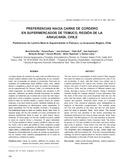Mostrar el registro sencillo del ítem
Preferencias hacia carne de cordero en supermercados de temuco, región de la araucanía, Chile
| dc.rights.license | http://creativecommons.org/licenses/by-nc-sa/3.0/ve/ | |
| dc.contributor.author | Schnettler, Berta | |
| dc.contributor.author | Reyes, Pamela | |
| dc.contributor.author | Henríquez, Juan | |
| dc.contributor.author | Ruff, Pablo | |
| dc.contributor.author | Sepúlveda, José | |
| dc.contributor.author | Denegri, Marianela | |
| dc.contributor.author | Miranda, Horacio | |
| dc.contributor.author | Sepúlveda, Néstor | |
| dc.contributor.author | Lobos Andrade, Germán | |
| dc.date.accessioned | 2011-09-29T18:33:51Z | |
| dc.date.available | 2011-09-29T18:33:51Z | |
| dc.date.issued | 2011-09-29T18:33:51Z | |
| dc.identifier.issn | 0798-2259 | es_VE |
| dc.identifier.uri | http://www.saber.ula.ve/handle/123456789/33792 | |
| dc.description.abstract | Los bajos niveles de consumo de carne ovina en Chile hacen necesario realizar estudios sobre las preferencias de los consumidores con el propósito de orientar la producción. Para esto se evaluaron las preferencias hacia distintos cortes, raza, estado (fresca o congelada) y precio de carne de cordero en compradores de supermercado de Temuco, Chile, y la existencia de diferentes segmentos de mercado, mediante una encuesta a 400 personas. Utilizando un diseño factorial fraccionado de análisis conjunto se determinó que el estado de la carne fue más importante que el corte o despiece, el precio y la raza, con preferencia hacia la carne en medias canales y cuartos, fresca, de cordero Araucano, a un nivel medio de precio. Mediante análisis de conglomerados jerárquicos se diferenciaron cuatro segmentos. El grupo mayoritario (47,7%) fue sensible al estado y al despiece, con preferencia hacia la carne en cuartos, fresca, raza Texel. El segundo grupo (25,3%) fue sensible a la raza, presentando las mayores preferencias hacia la carne en canal entera, fresca, Araucano. El tercer grupo (14,3%) fue sensible al precio, prefirió la carne en cuartos, fresca y Araucano. El grupo minoritario (12,7%) fue sensible al estado y precio, prefirió la carne en cuartos, Texel, y fue el único que prefirió la carne congelada y pagar un precio mayor. Los segmentos se diferenciaron según la edad, origen étnico y satisfacción con la alimentación. Por tanto, la estrategia de comercialización de carne de cordero en supermercados de Temuco debe centrarse principalmente en la venta de carne fresca y cortada en cuartos. | es_VE |
| dc.language.iso | es | es_VE |
| dc.rights | info:eu-repo/semantics/openAccess | |
| dc.subject | Carne de cordero | es_VE |
| dc.subject | Atributos de compra | es_VE |
| dc.subject | Segmentos de mercado | es_VE |
| dc.subject | Raza | es_VE |
| dc.subject | Cordero Araucano | es_VE |
| dc.title | Preferencias hacia carne de cordero en supermercados de temuco, región de la araucanía, Chile | es_VE |
| dc.title.alternative | Preferences for lamb’s meat in supermarkets in temuco, la araucanía region, Chile | es_VE |
| dc.type | info:eu-repo/semantics/article | |
| dc.description.abstract1 | The low levels of consumption of lamb meat in Chile suggest the need for studies on consumer preferences in order to orient production. A study with this object was carried out to evaluate preferences for various cuts, breeds, state (fresh or frozen) and price of lamb’s meat among supermarket buyers in Temuco, Chile, and the existence of different market segments, through a survey of 400 persons. Using a fractional factorial design for conjoint analysis, it was determined that the state of the meat was more important than the cut, the price and the breed, with a preference for meat in half carcasses and quarters, Araucano lamb, fresh, at a medium price level. Four consumer segments were distinguished by analysis of hierarchic conglomerates. The majority group (47.7%) was sensitive to the state and the cut, with preference for meat in quarters, fresh, Texel breed. The second group (25.3%) was sensitive to the breed, presenting the strongest preferences for meat in whole carcass, fresh, Araucano lamb. The third group (14.3%) was sensitive to the price, preferred meat in quarters, fresh, Araucano lamb. The minority group (12.7%) was sensitive to the state and price, preferring meat in quarters, Texel breed, and was the only group which preferred frozen meat and would pay a higher price. The segments were distinguished by age, ethnic origin and satisfaction with food-related life. Thus the commercialisation strategy for lamb in supermarkets in Temuco should concentrate principally on the sale of fresh meat cut in quarters. | es_VE |
| dc.description.colacion | 388-395 | es_VE |
| dc.description.email | bschnett@ufro.cl | es_VE |
| dc.description.frecuencia | Bimestral | es_VE |
| dc.identifier.depositolegal | 199102ZU46 | es_VE |
| dc.subject.institucion | Universidad del Zulia (LUZ) | es_VE |
| dc.subject.institucion | Universidad de Los Andes (ULA) | es_VE |
| dc.subject.keywords | Lamb’s meat | es_VE |
| dc.subject.keywords | Buying attributes | es_VE |
| dc.subject.keywords | Market segments | es_VE |
| dc.subject.keywords | Breed | es_VE |
| dc.subject.keywords | Araucano lamb | es_VE |
| dc.subject.publicacionelectronica | Revista Científica | es_VE |
| dc.subject.seccion | Revista Científica: Producción Animal | es_VE |
| dc.subject.thematiccategory | Medio Ambiente | es_VE |
| dc.subject.tipo | Revistas | es_VE |
| dc.type.media | Texto | es_VE |
Ficheros en el ítem
Este ítem aparece en la(s) siguiente(s) colección(ones)
-
Revista Científica - 2011- Vol. XXI - No. 005
Septiembre - Octubre 2011


